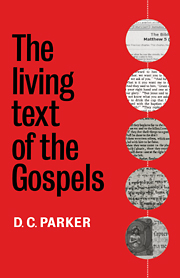Book contents
- Frontmatter
- Contents
- Preface
- List of abbreviations and frequently cited works
- 1 The theory
- 2 The materials
- 3 The practice
- 4 ‘As our Saviour taught us …’: the Lord's Prayer
- 5 The sayings on marriage and divorce
- 6 The story of the woman taken in adultery
- 7 Secrets and hypotheses
- 8 The endings of Mark's Gospel
- 9 The last three chapters of Luke
- 10 The development and transmission of the Fourth Gospel
- 11 From codex to disk
- 12 The living text
- Index of citations
- Index of Greek New Testament manuscripts
- Index of names and subjects
4 - ‘As our Saviour taught us …’: the Lord's Prayer
Published online by Cambridge University Press: 05 June 2012
- Frontmatter
- Contents
- Preface
- List of abbreviations and frequently cited works
- 1 The theory
- 2 The materials
- 3 The practice
- 4 ‘As our Saviour taught us …’: the Lord's Prayer
- 5 The sayings on marriage and divorce
- 6 The story of the woman taken in adultery
- 7 Secrets and hypotheses
- 8 The endings of Mark's Gospel
- 9 The last three chapters of Luke
- 10 The development and transmission of the Fourth Gospel
- 11 From codex to disk
- 12 The living text
- Index of citations
- Index of Greek New Testament manuscripts
- Index of names and subjects
Summary
St. Paul's whole teaching on liberty has to be applied to prayer.
Hans Urs von Balthazar, PrayerModern services often preface the saying of the Lord's Prayer with an invitation, for example, ‘As our Saviour taught us, so we pray.’ While we may accept that the words and the use are in harmony with the early tradition of Jesus, we shall certainly be mistaken if we believe ourselves to be uttering Jesus' words verbatim. As a matter of fact, this prayer contains within its short compass every conceivable problem that could afflict a Gospel saying: it exists in widely divergent forms, it includes a word otherwise unattested whose meaning is unknown, it contains an ambiguity, and its text was altered in the course of its transmission. For good measure, it is used in liturgical forms which draw on different Gospels.
To explain the last point first: in England, we use the word ‘trespasses’ or ‘sins’, which is from Luke, in an otherwise Matthaean form. In Scotland, the Matthaean word ‘debts’ is used.
The prayer is found twice in the Gospels: in the Sermon on the Mount in Matthew, as a part of teaching about prayer; and in Luke when Jesus has been praying, and his disciples ask ‘Lord, teach us to pray, as John taught his disciples.’
- Type
- Chapter
- Information
- The Living Text of the Gospels , pp. 49 - 74Publisher: Cambridge University PressPrint publication year: 1997
- 1
- Cited by



